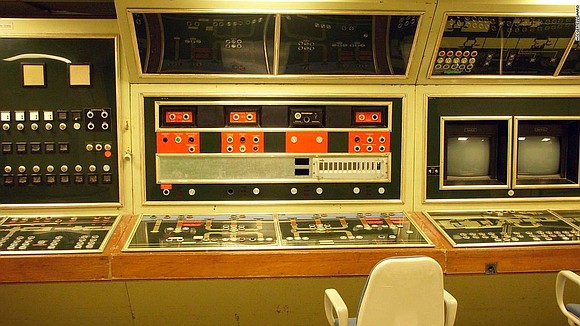10 best hidden Cold War sites in former West Germany
CNN/Stylemagazine.com Newswire | 4/4/2018, 7:59 a.m.
Marcel Krueger, for CNN
(CNN) -- Berlin and its infamous wall are the epicenter for Cold War tourism, but there are plenty of other sites around Germany that portray the tension between east and west after World War II.
Many important installations can still be found dotted throughout the country, relics of a time when West Germany was a Cold War hot spot.
There are hidden bunkers, former rocket silos turned into art galleries, and secret airfields next to highways.
Here's a list of 10 best Cold War sites west of the former German Democratic Republic (GDR) border.
Bunker Marienthal
The Government Bunker is a massive underground complex once intended to house the West German government in case of Soviet invasion or even atomic war.
Located about 16 miles south of the former capital of Bonn, among the beautiful vineyards of the Ahr Valley, it was built between 1960 and 1972 inside two railway tunnels.
It was decommissioned in 1997 but has since reopened as the Government Bunker Documentation Site, where visitors can visit the decommissioned control room and even a replica of the frugal bedroom of the German chancellor.
Bunker Marienthal; +49 2441 775171
Raketenstation Hombroich
If art in a former NATO missile base is your thing you might want to visit Hombroich near Neuss.
Built in 1967 as part of a new chain of air defenses, the base was operated first by US and then Belgian forces, and subsequently the German Federal Police's anti-terrorism unit, which briefly used the site for training after 1990.
In 1994 art collector and patron Heinrich Müller bought the base and turned a place of missiles into a place of culture. The halls, hangars, and even the observation tower were refurbished with the help of artists and architects like Erwin Heerich, Tadao Ando, and Alvaro Siza.
Today, visual artists, writers, and composers from all over the world live and work in the former missile base, which is open to the public for exhibitions and events..
Museum Insel Hombroich, Minkel 2, 41472 Neuss, Germany: +49 2182 887 4000
Marienborn border crossing
The border checkpoint Helmstedt-Marienborn on the border between Lower Saxony and Saxony Anhalt was once the largest and most important border crossing on the inner German border.
This was shortest land route between West Germany and West Berlin, so most transit traffic used the crossing, which became a bottleneck.
The GDR installations needed to process all that traffic (and catch potential spies and refugees from the east) were massive.
These have now been restored as a free museum with nearby rest area and restaurant by the side of Autobahn 2.
Marienborn, Memorial German Division Marienborn, Federal Highway 2, 39365 Marienborn, Germany; +49 (0) 39406 920 90
Highway strip on Autobahn 29
Another interesting rest area is the one on Autobahn 29, just north of Cloppenburg in Lower Saxony. This unsuspecting strip of concrete next to the roaring traffic was where massive C-130 Hercules transport planes and A-10 Thunderbolt fighter planes landed and took off during NATO exercise "Highway 84" in 1984.
Originally an idea of the Nazis, such impromptu airports were increasingly incorporated into German autobahns during the Cold War. (Even the United States' Ramstein Air Base evolved from a highway airport of the Luftwaffe). Most of these have now been reintegrated into rest areas or the autobahn itself.
The Barbarastollen
The Barbarastollen is a massive underground archive, intended to preserve Germany's cultural heritage from possible disasters.
Located in a disused mine near Freiburg im Breisgau, the archive holds microfilms with about 900 million images from German records and museums.
Built during the height of the Cold War in 1974, the archive contains such fascinating microfilm facsimiles as the treaty of the Peace of Westphalia which ended the Thirty Years' War (1618-1648), correspondence from the writer and statesmen Johann Wolfgang von Goethe, and the building plans for the Cologne Cathedral.
The entire complex is hidden under 400 meters of rock, and is intended to survive a nuclear war. It's estimated that its contents will survive for another 500 years without any serious damage.
Visits and tours are only possible with appointment.
The Barbarastollen, Freiburg im Breisgau, Baden-Württemberg, Germany.
Zweiländermuseum Rodachtal
The partition of Germany also deeply affected people living in rural areas away from the international spotlight.
At the Zweiländermuseum Rodachtal on the border between Thuringia and Bavaria there are 10 outdoor museum stations along the former frontier, plus the main exhibition in a typical local timbered house.
Here, visitors can find out about the events that were as dramatic and disruptive for the local populace as anything that happened in Berlin: complete villages demolished to make way for border fortifications, and also the Aktion Ungeziefer ("Action Vermin") in 1952, a compulsory evacuation of the citizens of Streufdorf against which they rose up in revolt.
Zweiländermuseum Rodachtal, 98646 Straufhain, Germany; +49 36875 50651
Haus der Geschichte
While the Haus der Geschichte ("House of the History of the Federal Republic of Germany") is a museum and not a site directly associated with the Cold War, it is still one of the best places in Germany to learn about the history of the FRG and GDR after 1945 and what followed after reunification.
Set in a spacious modern building in the former West German capital of Bonn, its fascinating permanent exhibitions contain US Jeeps, so-called Rosinenbomber (Raisin Bomber) aircraft that were used during the Berlin Blockade in 1948, and iconic cars from both sides of the Iron Curtain -- the VW Beetle and the Trabant.
It is also a great place to start when exploring the former capital. The house organizes guided tours of the nearby chancellor's bungalow and the former place of the Federal Assembly.
Haus der Geschichte, Museumsmeile, Willy-Brandt-Allee 14, 53113 Bonn, Germany; +49 228 91 65400
Pattonville
This is an example of how some of the former US Air Force sites and barracks were recycled after the Cold War. Pattonville is a large housing area built by the US Army just north of Stuttgart as part of the Stuttgart Military Community and named after World War II General George S. Patton.
From 1955 to 1992 Pattonville was also home to the Stuttgart American High School, which accommodated 1,200 students at its peak.
Formerly surrounded by fences and checkpoints, the installation was returned to the German government in 1994 and opened as accommodation for the local population.
The streets are named after various US states, while the nearby airfield is a base for a rescue helicopter.
Mödlareuth
Just like the Rodachtal, Mödlareuth is a small German village that was divided by the front line of Cold War Europe. The northern part of the village in Thuringia became part of the Soviet occupation zone in 1945. A series of border fences were constructed after 1952, and the wall separating the two halves of Mödlareuth went up in 1966, five years after the Berlin one.
The American troops in this area nicknamed Mödlareuth "Little Berlin," and in 1983 US Vice President George HW Bush visited and exclaimed "Ich bin ein Mödlareuther!"
The border was reopened to pedestrians in December 1989, and most of the remaining wall was demolished a year later.
Today, an open-air museum includes a portion of the original wall as well as replicas of border installations, allowing visitors to experience this little Berlin away from the tourist masses at Brandenburg Gate.
Mödlareuth, Mödlareuth 13, 95183 Töpen, Germany; +49 9295 1334
Grenzhus Schlagdorf
The inner German border also divided the northern parts of the country. The Grenzhus Schlagdorf (the "Border House Schlagdorf") is located near Lübeck. The memorial site and museum features a section of the former inner German border between the Baltic Sea and the River Elbe.
Instead of focusing on the perspective of one side, visitors here can get an impression of the experiences of citizens of West Germany, East German border guards or even GDR refugees.
Grenzhus Schlagsdorf, Neubauernweg 1, 19217 Schlagsdorf, Germany; + 49 38875 20326
Observation Post Alpha
There were not only GDR border guards observing the west from watchtowers, the west also looked east. One of those observation sites still accessible is Observation Post Alpha, between Rasdorf in Hesse and Geisa in Thuringia.
The post overlooked the famous Fulda Gap -- one of the main potential invasion routes for Warsaw Pact troops.
The post was decommissioned in 1991, and now houses a museum, a replica of the post, a strip of the former GDR border plus several military vehicles and also a visitors' center.
Point Alpha, Am Hummelsberg 1 D-36169 Rasdorf, Germany; + 49 6651 919030
Probstzella Railroad Museum
The Iron Curtain not only impacted pedestrians and the autobahn, but also rail travel. The Probstzella station in Thuringia, though technically not in West Germany, was where many train journeys from the west halted.
Used as a GDR border checkpoint from 1949 to 1990, nearly 20 million travelers were controlled and sometimes arrested here. It is still a working station, and the featureless concrete border checkpoint behind the 1885 station building houses the GDR railroad museum.
The exhibition provides information about the GDR regime, the limitations of rail transport between east and west and the many escape attempts via the Probstzella Border Railway Station.
Probstzella Railroad Museum, the Grenzbahnhof Museum, Thuringia, Germany




